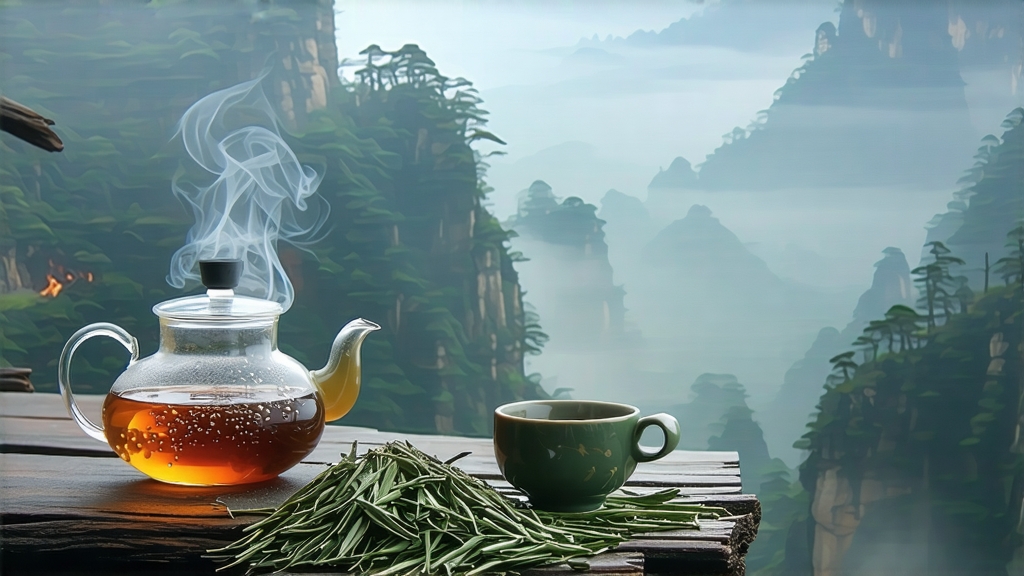
When European tea merchants first tasted a dark, wine-red liquor from the Wuyi Shan in 1604, they did not know they were drinking the world’s earliest intentionally crafted black tea. That tea, later Latinized as “Lapsang Souchong,” left the Fujian port of Xiamen as “bohea,” a corruption of the local name Wuyi, and sailed around the Cape of Good Hope to London parlors where it was praised for its “smoky perfume” and “honeyed depth.” In the four centuries since, Lapsang Souchong has split into two stylistic branches—the traditional pine-smoked export grade and the contemporary unsmoked “Wuyi black” reserved for domestic gourmets—yet both remain direct descendants of the same original withering, rolling, oxidizing, and firing sequence invented on the rocky cliffs of Tongmu Guan.
Geography is the first chapter of the story. Tongmu Guan, a protected enclave inside the Wuyi Mountain National Park, sits at 27° N where the Min River cuts a misty gorge of weathered tuff and granite. Day-night temperature swings of 10 °C force the indigenous xiao ye zhong (small-leaf) tea bushes to grow slowly, thickening the leaf cuticle and concentrating aromatic precursors. The same gorge funnels cool air from the Xianxia mountain range, creating a humidity pocket that allows for 18–20 hours of natural withering on bamboo racks without mechanical intervention. No other black tea enjoys such a cool, prolonged withering; it is the invisible first step that gives Lapsang Souchong its mellow, low-astringency body even before smoke enters the equation.
The cultivar matters next. While many gardens now plant the high-yield Fuding Da Bai for white tea, Tongmu farmers still keep seed-propagated bushes known collectively as “cai cha,” a landrace population whose leaves are no longer than 4 cm and whose petioles turn crimson when fully oxidized. Because the park is a UNESCO Man and Biosphere Reserve, pesticides are forbidden; instead, farmers encourage insectivorous birds and release Trichogramma wasps to control leafhoppers. The tiny bites of those hoppers trigger a jasmine-lactone response in the leaf, adding a covert floral note that balances later smoke.
Harvest obeys a narrow calendar. Only the first two leaves and a bud picked before Qingming (early April) qualify for authentic zhengshan (“original mountain”) grade. Pickers work 4 a.m.–10 a.m. while dew still glistens; any afternoon pluck is rejected because rising sap increases bitterness. Leaves are carried down the gorge in wicker baskets lined with fresh fern fronds to prevent bruising, arriving at the two-story wooden factory where every subsequent step is timed by the village bell tower rather than by clock or thermometer.
Withering happens on the second-floor loft, where bamboo slats rest over dying embers of pine root. The heat is too gentle to smoke, merely creating an updraft that carries humidity away through the tile roof. Over 18 hours the leaf loses 68 % of its moisture, entering the “soft leaf” state: a master can roll a leaf into a tight tube without it cracking. Oxidation follows in waist-high rattan baskets lined with wet cotton; the cotton is wrung out every 30 minutes to maintain 85 % humidity and 24 °C. After 3.5 hours the leaf edges turn chestnut while the lamina remains olive, the signature “two-tone” that cuppers later look for in the dry leaf.
Rolling is still done on 1950s cast-iron machines whose wooden battens have been burnished smooth by decades of tea. Pressure is applied in three bursts of 12 minutes each, with 5-minute rest intervals to rehydrate the leaf surface. The goal is to rupture 60 % of the cells—enough to release polyphenol oxidase but not so much that the leaf turns mushy. Once rolled, the leaf is sifted through a 10-mesh bamboo screen; anything that passes through is diverted to lower-grade “broken souchong,” while the retained twists move to the smoking loft.
Smoking is the stage most misunderstood abroad. Authentic Tongmu Lapsang is not dipped in smoke flavor; it is dried over soft, resin-poor pine (Pinus massoniana) whose root has been stored for two years to leach harsh terpen